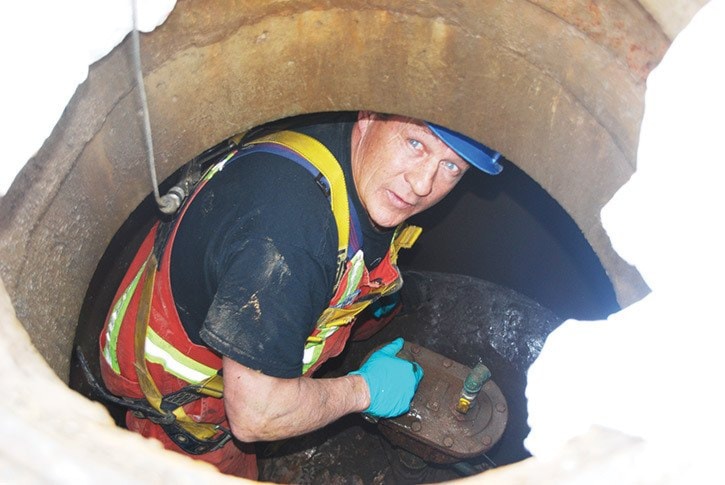On World Water Day people in Williams Lake will use eight million litres of water. That’s the average daily consumption of water at this time of year in the lakecity.
In the summer months the amount quadruples to 32 million litres a day, resulting in a total use of 4.5 billion gallons annually. The good news is that’s a 20 per cent reduction since 2006.
The water originates from four 70-metre deep wells on Scout Island, and one further down on Duncan Road.
Wells on Scout Island were punched out in 1969, the well at Duncan Road in 2004. Prior to that, a former building site at Duncan Road pumped drinking water from Williams Lake, but when the rules changed by the 1980s it was no longer a healthy option.
Before Duncan Road, the city’s drinking water came from the Williams Lake River below the Station House Gallery.
“The nice thing about the wells we have now is they are so deep. The aquifer is about 100 feet down and below a thick layer of glacial till,” City of Williams Lake manager of sewer and water Joe Engleberts said during a tour of the city’s water system. “The glacial till is a fairly porous layer that doesn’t allow water to flow through. There’s a slim chance of water becoming contaminated because the wells are so deep.”
It will travel through 117 kilometres of water main and 110 kilometres of sewer and sanitation networks, all buried two metres beneath the roads to insulate against freezing.
There are also 60 kilometres of storm and sewer lines that have to be maintained, along with 500 fire hydrants.
Twice a year city crews flush the water mains at different zones, plus all components have life spans.
“We also try and be at least one year ahead of the pavement management program so we’re not digging up new roads. We’ve done South Lakeside already and will do Pigeon, Western and 11th Avenue.”
There’s a one per cent replacement rule in water and sewer planning, he said.
“We have nine reservoirs in four separate zones,” Engleberts said.
The city’s water staff consists of six full-time and two seasonal employees tasked with water treatment and distribution and waste water collection and treatment.
Because every water system is unique, it’s nice to have experienced staff, Engleberts said, adding some of his employees have been there for more than 30 years, others more than 20.
“They know the quirks of our water system. It gets into a rhythm that in some cases is day to day, month to month, or even year to year.”
Take the summer months for example, he explained.
People are running air conditioners and cooling systems or watering gardens and lawns.
“We have restrictions because the use quadruples, not because the water itself is at a low level. When the daily demand increases so intensely, the movement of water itself through the system intensifies.”
And often the water has to travel from Scout Island through a few stations to meet that demand.
Each zone has an associated station. Each station has pumps to gather water from reservoirs and send it to where its needed.
At the stations water is tested daily for chloroform and e-coli. Four samples taken are sent to an independent lab weekly, monthly, semi-annually and yearly, and the parameters increase, testing for things like arsenic or zinc.
The sampling results are available for the public to view on the city’s website, along with the annual water report, Engleberts noted.
“We’ve never had a boil water advisory,” he added.
A Supervisory, Control and Data Acquisition (SCADA) computer program has been in place at the city for 15 years.
The system will contact the on-call employee at home if there’s a problem.
“They can access it remotely from home so they don’t have to come down to station but go right to the field where the problem is. The computer program is the communicator, transferring information from a system that acts like its own brain.”
Even if the computers go down, the “brain” system will continue working so that everything’s not relying on one system.
The system is also totally self-sufficient, communicating through a radio system that’s been working really well for everyone.
Aside from immediate information, the computer system stores historical data. It helps determine trends, Engleberts said.
Eventually SCADA will be available to the public and citizens will be able to take virtual tours.
Water is treated with chlorine with a system that makes sodium hypochlorite at the stations on Scout Island and Duncan Road.
“Before it was chlorine gas, which is dangerous, but now there’s no hazardous materials used,” said George Bell. “We’ve been gas free for five years.”
When the water first arrives in the station it is filtered to remove green slime, using a diluted salt brine.
Once its chlorinated, the water sits in large tanks before being pumped to other stations.
Up until 2011, the city added fluoride to its water, but after a referendum discontinued the practice.
“Many communities are trending away from it,” Engleberts said.
When asked about the future of the city’s water supply Engleberts expressed confidence the demand can be maintained for 30 to 40 years.
“We are looking at the future of our system and sources, the San Jose watershed, the aquifer and its lifespan. We aren’t going to run out tomorrow but it’s important to be looking well into the future,” he explained, no pun intended.
